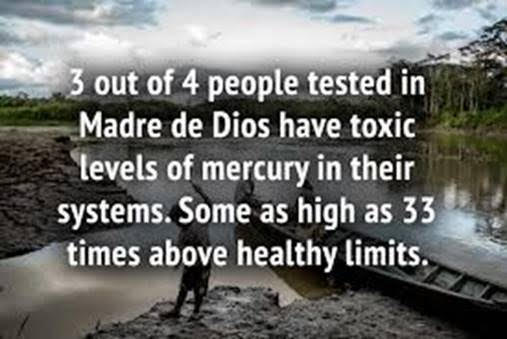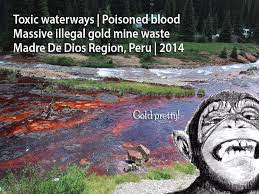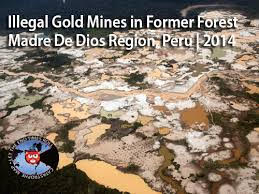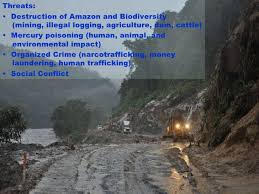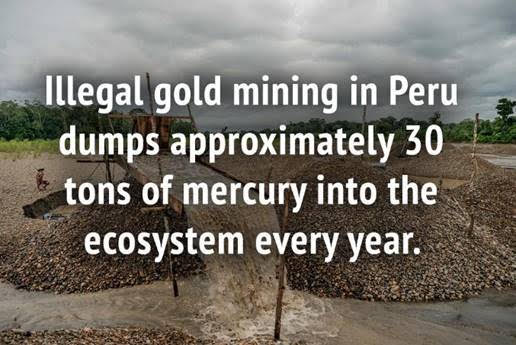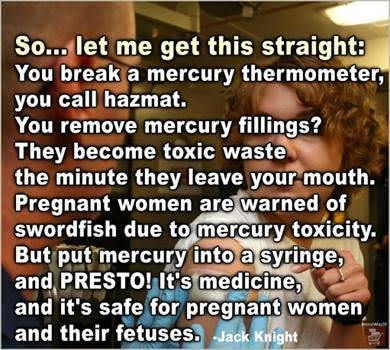Duke University Bamboozled by a Sociopathic Corporate Mining Giant’s Gift of Money to Help It Exploit the Indigenous People of Peru
TRANSCEND MEMBERS, 8 Jan 2018
Gary G. Kohls, MD | Duty to Warn – TRANSCEND Media Service
3 Jan 2017 – Below are two articles that nicely illustrate the cunning methods that ALL multinational mining, exploration, drilling, energy extractive or oil transporting corporations use to try to sanitize what in reality are greedy designs to enrich corporate stakeholders by raping, stealing, exploiting and permanently polluting the land, water and air that really has always belonged to the indigenous people and who simply want to protect what has always been theirs.
The first article illustrates how an otherwise respected major educational institution like Duke University (of Durham, North Carolina) could be easily bamboozled by financial enticements from an exploitive corporation. (Duke University was, incidentally, founded and funded by robber baron James Buchanan Duke, an exploitive tobacco and electric power industrialist that at one time acquired a monopoly on cigarettes and thus gained enormous wealth by marketing a highly addictive and deadly product.)
Hunt Oil gave Duke $1.9 million plus a bunch of empty promises to “study” the health of indigenous Peruvians who were doomed to be exploited and poisoned by corporations like Hunt. Also promised was an additional $1.7 million per year if Hunt would be allowed to begin drilling. I could find no evidence that any more money that the initial payment passed from Hunt to Duke.
Duke has not published a single follow-up article about the project since the 2014 article below. One can presume that nothing came of the study, since Hunt has also not said anything about any further relationships with Duke on its website. And Duke has not admitted to having been bamboozled. Everybody but the exploited ones in Peru were happy with the arrangement.
Hunt Oil Company is based in Dallas, TX and has always been in the oil and gas extraction game. It has always only been in the game for the money. Its founder, the notorious bigamist H L Hunt, was once one of the richest people in the world and the Hunt family was the obscene inspiration for the hit television series Dallas. He had one of his sons lobotomized for abnormal behaviors, just like one of President Kennedy’s sisters was. Two of Hunt’s sons conspired to corner the world’s silver market and H L did a deathbed confession to one of his sons for his role in the assassination of Kennedy, who was roundly hated by all Texan oilmen.
Hunt Oil has never been a friend of the planet, the environment or of the indigenous people who have valuable exploitable resources on their land. Courageous and honorable indigenous water-protectors and their allies – such as those that emerged at Standing Rock, North Dakota last year – have always seen through the game of wealthy people and their corporations, and Peruvian indigenous people are no different, with any number of those resisters already having been driven off their land and even assassinated by company-paid thugs.
Hunt Oil has liquid natural gas (LNG) operations in the Bakken Oil fields in North Dakota, as well as in Niger and Yemen. The privately-owned company is just one of many similar corporations that have profited mightily while the indigenous people whose lands they have stolen have suffered enormously.
Over its ignominious 80-year history, Hunt Oil has victimized the people, land, water and land of the following nations: Argentina, Australia, Benin, Canada, Chile, Ethiopia, France, Ghana, Guyana, Namibia, Niger, Oman, Peru, Portugal, Romania, Togo, United Kingdom, and Yemen.
It can be safely said that none of the working people of those mostly third world nations are better off for having Hunt occupy, exploit and despoil their land.
And it would also be safe to say that Hunt’s corporate propaganda machine, with the eager help of the area’s paid-off media groups and bribed government officials (not to mention the local Chambers of Commerce) over-promised jobs, jobs, jobs to the desperate and thus gullible residents who were doomed to be left holding the pollution bag and be forced to do the impossible clean-up job when the guilty company moved out, declared bankruptcy or was sold to another cunning corporation with a larger stable of skilled shyster lawyers to get the de-funded EPA to do the Super Fund clean-up at taxpayer expense.
The heroic indigenous groups that have resisted Hunt Oil and their fellow equally rapacious corporations in North Dakota, Peru, Niger, Yemen, etc, etc have been consistently treated with disdain and cruelty by hired, white supremacist, heavily-armed mercenary thugs. Yet the out-spent protesters continue to do whatever they can to non-violently resist the evil designs of the uncountable numbers of corporate criminals that are in the business of serial hit and run operations.
Northern Minnesotan environmentalists are familiar with the many foreign extractive sulfide mining, oil and gas corporations that have evil designs on Minnesota’s natural resources. Multinational corporations such as Canada’s Enbridge, Chile’s Antofagasta, Canada’s PolyMet, Switzerland’s Glencore, Canada’s Twin Metals, and, at least by their silence – most of Minnesota’s (and Wisconsin’s) corporate-influenced educational institutions, most of each state’s corporate-controlled legislators and most of each state’s corporate-controlled media.
None of the above entities has ever shown any sign of listening to reason whenever environmentalists bring up the huge potential of disastrous tailings ponds ruptures or the permanent pollution of aquifers, ground water and surface water (including the St Louis River and therefore Lake Superior) from hazardous waste contamination that the mining industry admits will be stored behind 250 foot-high, dissolvable earthen dams for eternity. Such earthen dams are vulnerable to torrential rains that are becoming increasingly common phenomena.
Nevertheless, Hunt Oil easily convinced Duke University to partner with it, obviously for photo-op, public relations purposes rather than because of any real concern for the health of the Peruvian people that live in the Amazon River headwaters region.
Duke University, to its everlasting shame, naively fell for the well-crafted lies of a sociopathic corporate entity that inevitably leaves disasters behind when the resources and wealth have been thoroughly extracted.
There are lessons in this story that all people concerned about our mortally-wounded planet need to re-learn and apply to local areas that are targeted for exploitation and poisonings by compassionless corporations. Gary
DUKE university Team Studies HEALTH RISKS OF GOLD MINING and Oil/Gas DRILLING IN PERU
(Project Is totally funded by a $1.9 million Dollar grant from the infamous Hunt Oil Company – which is intending to exploit the Peruvian Amazon’s Gas resources)
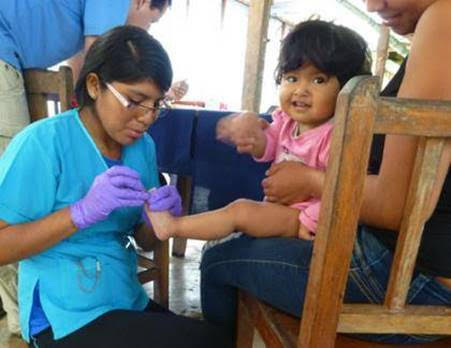
A healthcare worker collects a small blood sample from a Peruvian toddler as part of a large-scale assessment of human health around a (historically) protected area (but now) slated for gold mining and oil and gas drilling.
Duke University researchers have launched a new study to provide the first large-scale independent assessment of risks to human health and water resources from gas exploration and gold mining in one of the most biodiverse regions on Earth.
The study, which began in July, examines risks associated with drilling and mining in and around the Amarakaeri Communal Reserve, a protected area in southeastern Peru’s remote Madre de Dios region.
Scientists from the United States and Peru are taking part in the initiative, which is funded by a one-year, $1.9 million grant from Hunt Oil Company. Additional funding for three more years of study, worth roughly $1.7 million a year, is contingent on gas discovery in the area.
“Through this agreement, the company that stands to benefit from the extraction of the region’s natural resources also agrees to underwrite an independent scientific investigation to identify and monitor the impacts without any conditions on data sharing or publication of findings,” said William K. Pan, assistant professor of global environmental health at Duke’s Nicholas School of the Environment and the Duke Global Health Institute.
The Amarakaeri reserve was established in 2002. It encompasses more than 1,500 square miles of ecologically important forests and headwater river basins and is home to the indigenous Harakmbut, Yine and Machiguenga peoples, who rely on the forests and rivers for food, water and other basic needs.
In 2006, the Peruvian government opened about 90 percent of the reserve to Texas-based Hunt Oil for gas exploration. Disputes over the potential environmental, human health and social justice impacts of drilling in the reserve have led to lawsuits and bloodshed, including the shooting deaths of 12 indigenous protesters by Peruvian police in 2009.
Small-scale artisanal gold mining has occurred in Madre de Dios since Inca times. In recent years, the pace and geographic extent of the operations have increased dramatically around the reserve as miners, spurred by rising gold prices, blast and clear more of the region’s forests and floodplains in search of new deposits. Hunt Oil is not involved in this mining.
“Our primary objectives are to establish baselines for human health and environmental conditions in and around Amarakaeri before exploratory drilling begins, and to monitor these indicators over time to see how continued mining and expanded drilling may affect key indicators,” Pan said.
The researchers will examine human biomarkers for cardiovascular and kidney function, nutrition, and infectious diseases in local populations to monitor the effects of exposure to particulates, mercury and other environmental risk factors from gas and gold mining operations. The project includes a comprehensive epidemiological study to evaluate how the clearing of forests for roads, agriculture, drill sites, mining, housing and support services affects the transmission of malaria and other diseases. The team will conduct hydrological assessments to identify potential impacts of gas extraction and gold mining on the local hydrological cycle and on downstream water quality. And they’ll work with local communities to develop strategies for improving public health.
“This information, much of which currently is critically lacking, is essential for developing long-term strategies for development in the region,” Pan said. “For example, creating reliable hydrological and transport models within the Madre de Dios region will help us better understand mercury distribution and exposure from mining activities and eventually the effect drilling will have in altering this distribution.” Such models, he explained, are necessary for projecting future impacts of increased industrialization in the region and devising ways to reduce or avoid them.
Duke faculty members working with Pan on the new study include Joel Meyer, Mukesh Kumar, Jennifer Swenson, Jim Zhang, and Marco Marani from the Nicholas School; Heileen Hsu-Kim from Duke’s Pratt School of Engineering, where Marani also holds a faculty appointment; Chris Woods and John Stanifer from Duke’s School of Medicine; and Ernesto Ortiz from the Duke Global Health Institute.
Other partners are Jaime Miranda of the Universidad Peruana Cayetano-Heredia in Lima, Peru, and Fred Stell and Gisella Vasquez of U.S. Naval Medical Research Unit No. 6.
Peru: Hunt Oil Contract to Reignite Amazon Uprising?
By Bill Weinberg – (November 2, 2009)
From: https://nacla.org/news/peru-hunt-oil-contract-reignite-amazon-uprising
After the indigenous uprising in Peru’s Amazon region in June, it appears that an indigenous pledge to physically resist the operations of Dallas-based Hunt Oil on communal rainforest lands could reignite the uprising. In what is shaping up as an important test case, Hunt Oil is opening trails in preparation for seismic exploration within an indigenous reserve in Madre de Dios.
After the indigenous uprising in Peru’s Amazon region in June, the country is in many ways fundamentally changed. For the first time, indigenous leaders from the rainforest are in direct dialogue with the highest levels of government. For the first time, a powerful alliance has emerged between rainforest peoples, highland campesinos, and urban workers, who joined in the protest campaign. The days when Lima’s political elite could treat the rainforest as an internal colony seem definitively over.
Yet there has been a high price in human lives, and only the most controversial of President Alan García’s legislative decrees, which triggered the uprising, have been overturned. These decrees-promulgated under special powers granted to García by Peru’s congress in 2008 to ready the country for the new U.S. free trade agreement-would undo a generation of progress in protecting indigenous territorial rights in the rainforest, opening indigenous lands to oil drilling, logging, and other forms of resource extraction as never before.
The southern Amazon region of Madre de Dios was the scene of considerable unrest during the past two years’ worth of protests. In early July 2008, regional government offices in Puerto Maldonado, the regional capital of Madre de Dios, were occupied for three days. The city was paralyzed as the Native Federation of the Río Madre de Dios (FENAMAD), an indigenous Amazonian organization, joined the regional campesino union in launching the general strike. Campesino demands for land titles were united with indigenous demands for territorial rights, while federations representing small miners, Brazil-nut harvesters, Puerto Maldonado moto-taxi drivers, and other sectors also joined the strike, uniting in an Alliance of Federations.
Then the regional government offices were burned down. It remains unclear who was responsible, but indigenous protesters were accused. More than a year later, the burned-out shell of the building still stands, its walls scrawled with graffiti. The words have been painted over in an attempt to obscure them, but they are still readable: “La tierra es del pueblo” (The land is the people’s) and “No se vende, se defiende” (We don’t sell out, we defend ourselves). Some 25 were arrested, and Jorge Payaba, a former president of FENAMAD, was beaten and hospitalized. His successor, Antonio Iviche, went into hiding for several days before the charges against him were dropped.
Now it appears that an indigenous pledge to physically resist the operations of Dallas-based Hunt Oil on communal rainforest lands could reignite the uprising. In what is shaping up as an important test case, Hunt Oil is opening trails in preparation for seismic exploration within an indigenous reserve in Madre de Dios.
Hunt signed a contract with Peru’s government to explore within Lot 76 in 2006 and later brought in the Spanish firm Repsol as a half-partner in the project. The lot overlaps with much of the Amarakaeri Communal Reserve as well as 16 titled native communities-including those 10 that are adjacent to the reserve and jointly responsible for managing it with the national government. Hunt’s exploration work calls for 18 seismic lines with 20,000 detonation points across the southern part of the reserve. This work is to be serviced by 166 mobile camps with heliports, as well a main base camp. FENAMAD said these activities are to take place in the most sensitive part of the reserve, near the headwaters of the rivers that flow into the Río Madre de Dios.
FENAMAD’s Iviche, a traditional Harakmbut leader, said the oil project threatens the forests and waters of the reserve, which was established in 2002 for the use of local Harakmbut, Yine, and Matsigenka communities.
“Our communities have decided not to allow these activities in the communal reserve,” Iviche said, charging that Hunt is operating without the consent of the area’s native inhabitants, most of whom oppose the oil company’s presence. “They have never consulted with the communities.” Failing to adequately consult indigenous communities on land-use issues in their territories is a violation of both international standards and Peru’s constitution.
The Amarakaeri reserve was created following years of petitioning by FENAMAD-and a march in April 2002 by some 1,000 indigenous people in Puerto Maldonado. Each of the 10 communities bordering the reserve has its own range within it for hunting and gathering, but indigenous residents cannot enter the zonas silvestres, or wild zones-yet this is where Hunt is now operating.
Additionally, Lot 76 borders (or nearly borders, separated by a strip barely two thirds of a mile wide) two national parks. On the north, it borders, and slightly overlaps with, a State Reserve for Peoples in Voluntary Isolation. This was created along with the Amarakaeri reserve to protect “uncontacted” Matsigenka bands believed to be living in this zone.
On September 9, FENAMAD sought an injunction against Hunt’s exploration work before the Madre de Dios Superior Court of Justice, the equivalent of a local district court. Said FENAMAD secretary Jaime Corisepa: “We have to attack on every level, using the courts, but we are ready to defend our territory physically.”
In 2007, Hunt began holding “information workshops” at FENAMAD’s offices in Puerto Maldonado and at some of the communities bordering the reserve. Corisepa denies these were consultations, saying the company representatives were just “announcing what they were going to do.”
One community, Shintuya, has signed an agreement with Hunt to accept $30,000 in compensation for allowing the company access to its titled lands. There is a dispute as to whether the community approved this decision by the two-thirds vote required under Peruvian law.
FENAMAD said Hunt is required at a minimum to compensate the two communities whose lands it seeks to enter-Shintuya and Puerto Luz, at the eastern and western ends of the seismic lines, respectively-and the Amarakaeri reserve’s governing council, known as the Administrative Contract Executive (ECA). Hunt has no deal with Puerto Luz, and a tentative deal with the ECA is now in question.
“Laws are being systematically ignored by the company and the government,” Corisepa charges. “The Peruvian state has a hydrocarbon policy that violates the rights of indigenous communities. This is what the Amazon uprising was about.”
At a September 13 meeting at FENAMAD’s Puerto Maldonado office, leaders from the 10 communities bordering the Amarakaeri reserve met privately to hash out their position, then invited three Hunt Oil representatives to receive their declaration. The atmosphere in the small thatched-roof conference room was tense.
Three communities, Shintuya, Puerto Luz, and Diamante, dissented from the decision to issue a declaration opposing the project. Nonetheless, the joint statement from FENAMAD and the ECA opposing the Hunt-Repsol presence in the reserve demanded that “this decision be respected by the state as well as the said companies.”
Anoshka, a Harakmbut leader from the community of Masenawa who is also a popular singer on the local cumbia circuit, gave the most impassioned statement. “I plead with you from my heart to respect our desire,” she said, directly addressing the Hunt representatives. “A majority of our communities have decided no. The conflicts you are sowing among us will not succeed, but you are already causing damage to our communities.”
Speaking of the Amarakaeri reserve’s management plan ostensibly drawn up with input from the 10 communities, she added: “The master plan said the communities favor the oil company. This is a lie and we will never accept this.”
The master plan, drawn up by the government natural-resources agency, is strongly contested. Although the ECA signed off on it, many Harakmbut charge the communities were not informed of last-minute changes that afforded oil companies easier access to resource exploitation in the most sensitive area of the reserve. Also at issue is the plan’s “recommendation” that the ECA accept any hydrocarbon contracts that the state permits in the reserve.
FENAMAD is especially concerned about the status of the high jungle in the south of the reserve, near the border with Cuzco region, which protects the watersheds of several tributaries of the Río Madre de Dios that run through the reserve. FENAMAD argues that under Peru’s Water Law, this area should be a strict protection zone, which would bar resource exploitation there. Instead, it was reclassified as a zona silvestre, affording a lower level of protection.
Equally controversial is the environmental-impact study produced for the Hunt project by the Peruvian firm Demus. In April, Demus workers in the community of Barranco Chico were confronted by local residents armed with clubs, who chased them from their lands. FENAMAD challenged the impact study before the Mines and Energy Ministry as what Corisepa calls a “plagiarism”-basically a cut-and-paste job from earlier studies elsewhere in the Amazon. Nonetheless, the ministry accepted it in June.
Hunt workers may be the next to be physically confronted. At the end of the meeting, Iviche announced that if Hunt doesn’t withdraw from the reserve, the communities are prepared to carry out a desalojo-eviction.
Silvana lay, a forestry engineer who serves as Hunt’s director of environmental health and safety for the Lot 76 project, defended the company’s position in comments outside the meeting at the FENAMAD office.
“We weren’t going to come in until the master plan was approved,” she said. “We waited two years, and during that period we met with the communities and gave information. We are working in the part where we are allowed to work under the rules that were put in the plan. The last thing we want is a dangerous situation for our workers or the communities.”
While the ECA did not have to sign off on the impact statement, Lay points out that public hearings on the study were held in the village of Salvación. “We held workshops with the communities on whose lands we are going to work, with the ECA invited.”
Lay insists that Hunt, in contrast to many resource companies in Peru, is committed to playing by the rules. “We have the [impact statement] approved. We have the master plan approved. We did workshops with the communities-all this before we started our work. We have the signatories of everybody saying the work can go ahead-within the rules, of course. And then we received a call saying the work cannot go ahead.”
She points out that the $380,000 offered in compensation to the ECA is nearly 25% of the Amarakaeri reserve’s five-year budget. It is now in question whether the ECA will accept this money. She said the $30,000 pledged to Shintuya is forthcoming, and that Hunt will stay off of Puerto Luz community’s lands until a compensation deal is finalized. Hunt’s overall budget for the exploration project is $17 million, she said.
Lay asserted that the Hunt contract is in the best interests of the communities. “They can use that money to police the reserve against illegal logging and mining. The illegal exploitation is the greatest threat to the reserve, while the media and government are checking up on us. We are a good opportunity for the reserve.”
FENAMAD attorney Milton Mercado rejects Lay’s portrayal. “The ECA has never signed any document allowing Hunt in the reserve,” he said. While the master plan allows oil exploitation in a general sense-with approval by the National Service of Protected Areas-it makes no reference to the Hunt contract. And this provision was added above the protests of the communities, he added.
“The only consultation has been with Shintuya and Puerto Luz,” Mercado said. Consultation is mandated by the International Labor Organization’s Convention 169, to which Peru is a signatory. The principle is also enshrined in Article 6 of Peru’s constitution.
Mercado sees a hopeful precedent in a February ruling by the Constitutional Tribunal, Peru’s highest court, in a case concerning Lot 103-which includes the Cordillera Escalera Regional Conservation Area, a high jungle that protects the headwaters of important rivers in northern San Martín region. Citing potential damage to aquifers, the tribunal ruled against a consortium including Repsol, Petrobras, and Occidental Petroleum, ordering a halt to exploration in the reserve until a master plan is in place.
FENAMAD’s case against Hunt likewise focuses on the issue of protecting aquifers. But Mercado points out that it is the first in the history of Peru to rest on lack of consultation with indigenous communities-and a favorable ruling would be precedent-setting.
Almost all of the Madre de Dios region is divided into hydrocarbon exploration lots. Sapet, a Peruvian venture of China National Petroleum, has a license for Lots 113 and 111-the former covering the Reserve for Peoples in Voluntary Isolation, and the latter actually covering the town of Puerto Maldonado. The company has pledged not to explore in the reserve, for the moment at least. Lot 157, on unprotected lands to the east of the large protected areas, is currently suspended following the “Petrogate” scandal, in which officials are accused of kickbacks in the granting of concessions to Norwegian company Discover Petroleum.
These medium-sized firms are clearly viewed as an advance guard for the industry majors, who mostly abandoned operations in the Peruvian Amazon because of instability in the 1990s-and who García openly hopes to woo back.
Shell Oil explorations in area in the mid-1980s took a grave toll in disease on the recently contacted Yaminahua people in the north of Madre de Dios, who now have a titled community in neighboring Ucuyali region.
A decade later, a consortium including ExxonMobil and Elf began exploration in Lot 78-covering nearly the same territory as the contemporary Lot 76. This lot was reorganized in subsequent years as the communities around the Amarakaeri reserve were being titled.
In addition to hydrocarbons, timber is being massively exploited in Madre de Dios, mostly by Peruvian firms for export to the United States and China. There are legal concessions on state land in the largely unprotected eastern half of Madre de Dios-as well as much illegal exploitation in the protected areas.
Gold is next in line in the local resource boom. Legal placer and dredge mining concessions operate on the region’s rivers. But illegal and highly destructive hydraulic mining goes on in pirate operations.
A hydroelectric project is pending on the Río Inambari, with the Brazilian firm Odebrecht likely to get the contract. The Inter-Oceanic Highway linking Brazil’s Atlantic coast with Peru’s Pacific is also under construction through Madre de Dios.
This matrix of development interests could make the frontier zone of Madre de Dios a very different place in a few short years-and many young indigenous people fear what the future will bring. Wili Corisepa, a young Harakmbut from Shintuya who works with FENAMAD, said: “In the time of the missionaries, in the time of the rubber, of the timber, and now the oil, they all lied to us. It is the same person wearing a different mask.”
_______________________________
Note to Editors: William Pan (heading up the Duke research team) can be reached for additional comment at william.pan@duke.edu.
 Dr Gary Kohls is a retired physician from Duluth, MN, USA and a member of the TRANSCEND Network. In the decade prior to his retirement, he practiced what could best be described as “holistic (non-drug) and preventive mental health care”. Since his retirement, he has written a weekly column for the Duluth Reader, an alternative newsweekly magazine. His columns mostly deal with the dangers of American imperialism, friendly fascism, corporatism, militarism, racism, and the dangers of Big Pharma, psychiatric drugging, the over-vaccinating of children and other movements that threaten American democracy, civility, health and longevity and the future of the planet. Many of his columns are archived at http://duluthreader.com/search?search_term=Duty+to+Warn&p=2; http://www.globalresearch.ca/author/gary-g-kohls; or at https://www.transcend.org/tms/search/?q=gary+kohls+articles; ggkohls@gmail.com
Dr Gary Kohls is a retired physician from Duluth, MN, USA and a member of the TRANSCEND Network. In the decade prior to his retirement, he practiced what could best be described as “holistic (non-drug) and preventive mental health care”. Since his retirement, he has written a weekly column for the Duluth Reader, an alternative newsweekly magazine. His columns mostly deal with the dangers of American imperialism, friendly fascism, corporatism, militarism, racism, and the dangers of Big Pharma, psychiatric drugging, the over-vaccinating of children and other movements that threaten American democracy, civility, health and longevity and the future of the planet. Many of his columns are archived at http://duluthreader.com/search?search_term=Duty+to+Warn&p=2; http://www.globalresearch.ca/author/gary-g-kohls; or at https://www.transcend.org/tms/search/?q=gary+kohls+articles; ggkohls@gmail.com
Bill Weinberg is author of Homage to Chiapas: The New Indigenous Struggles in Mexico (Verso, 2000) and editor of the website World War 4 Report (ww4report.com). Research support for this article was provided by the Investigative Fund at the Nation Institute.
This article originally appeared on Transcend Media Service (TMS) on 8 Jan 2018.
Anticopyright: Editorials and articles originated on TMS may be freely reprinted, disseminated, translated and used as background material, provided an acknowledgement and link to the source, TMS: Duke University Bamboozled by a Sociopathic Corporate Mining Giant’s Gift of Money to Help It Exploit the Indigenous People of Peru, is included. Thank you.
If you enjoyed this article, please donate to TMS to join the growing list of TMS Supporters.

This work is licensed under a CC BY-NC 4.0 License.
